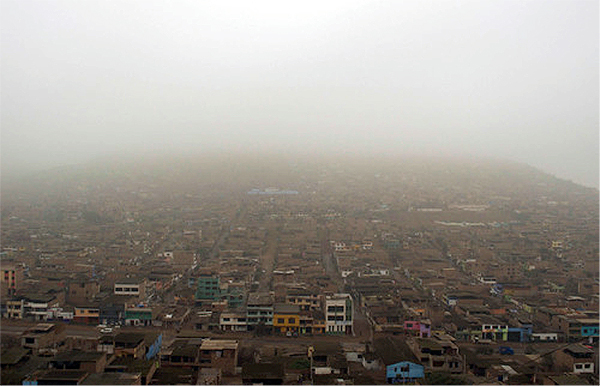Los pueblos jóvenes is the name given to the many shantytowns scattered throughout the sprawling city of Lima. Nueva Esperanza was the first community of its kind that I visited, accompanying MEDLIFE nurse Ruth through the maze of brick and sheet metal houses scattered along rolling hills and shrouded in a dense, cold, misty fog. During the winter months, May to November around the equator in the Southern Hemisphere, Lima is encapsulated in a dome of perpetual fog that puts San Francisco’s famous weather to shame. In the 6 weeks that I have been here, there have been 3 sunny days!
Esperanza. It means hope. Something that is difficult to find in such a marginalized, destitute community. But I could see it. I could feel it when Carlos greeted the people in their homes. In my MEDLIFE “voluntario” vest, I too was a beacon of hope, a difficult concept for me to grasp.
Lima is the third largest city in South America and one of the largest cities in the world without a metro. It is a city of striking dichotomies. One minute I was in the most poverty-stricken community I have ever seen. A thirty minute combi ride later, and I am in upscale Barranco eating ceviche in an old, white colonial mansion that has been converted into a restaurant. It felt wrong. How could this much poverty exist so very close to modern excessive consumption? Lima is really two separate worlds, existing side by side and united only by their geographic proximity. This is a reality not only here in urban Peru but all across the world.
On one Thursday evening, we traveled to a community in Villa El Salvador. It was my first trip to the slums in the dark. I stayed right behind Carlos as he jumped on the minibus. I clenched my fists tightly around the metal handlebar on the ceiling of the combi as the driver swerved through the traffic fearlessly using his seasoned driving skills and the occasional honk as our sole lifeline. Forty minutes of bumping and bouncing later, we hopped off the bus. I looked around and felt as if we had entered a completely different universe. Stray dogs ran through the streets and women sold exotic fruits and deep fried snacks from their street-side stalls. On either side of the main road, muddy hills speckled with dilapidated huts jutted into the dense fog. We were now in second world: los barrios.
The lights illuminated the dense fog as we walked to the soccer field where the meeting would take place. We arrived and were greeted by over one hundred people, who eagerly awaited our words. Carlos and Jorge, the MEDLIFE Directors, addressed the crowd, explaining how we would host a mobile clinic in August and providing medical services free of charge. After this statement, an outbreak of mutterings started from the crowd. Then came the bombshell: “But why do you want to help us for free?” What was the ulterior motive? What do you want in return? Are you going to take our organs and sell them on the black market? Carlos smiled. “We are all people in this world. It is our duty to help each other. If everyone worked for the good of humanity, we would not live in a world—we would live in paradise.” At that moment, I felt a definite, empowering change in mood. Something was different. Fear had parted to make way for a new feeling: esperanza.
That night, the people were incredibly gracious and welcoming. As we listened to the dialogue between MEDLIFE and community leaders, we were served hot tea, choclo, and queso fresco. Choclo is Peruvian “corn on the cob.” The corn is not like the corn I am used to – it is more like hominy that you can find in the Southern United States, with huge, succulent kernels. I savored this authentic Peruvian experience in the dark hills of Lima.
Before the meeting finished, Carlos emphasized one last point. MEDLIFE is more than willing to help as much as possible, with medical clinics and development projects such as staircases and toilets, but only if the community is organized and agrees to work together with us. Carlos is very clear about this. If the organization is there, “Bienvenidos!” as he says. At MEDLIFE, we always ask the question: “If MEDLIFE disappeared tomorrow, what would happen to our work?” Would it continue to help the communities? Is the work sustainable? Does it exist after we stop directly supporting it? This is key, because if the answer is no then the work is not sustainable and worthwhile.
At the end of the meeting, we were brought out of the hills in tiny mototaxi rickshaws owned by community members. The interns crammed into the vehicles three by three, and we descended the hills in a caravan, blinded by a dark, dense fog. We talked to the drivers about Quechua, the language of the Cusco immigrants, or Cusqueños, and about their move from the Andean farmland to the urban slums. Eventually we emerged out of the fog and onto the main road, and grabbed a bus back to the second world of Lima: modern, developed, urban. Together but apart, I sometimes wonder if there is a portal between the two, merging two distant realities into a single city.



